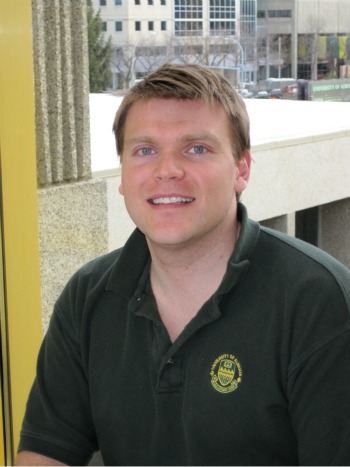
Doctoral student Mike Nelson won top honours at the Canadian Society of Exercise Physiologists conference for his research into how the heart functions in the heat-stressed body.
At last year's Canadian Society of Exercise Physiologists' conference in Toronto the top graduate student award went to doctoral student Mike Nelson, whose presentation, "Biventricular function during passive heat stress: Influence of aerobic fitness" was recognized as having broken important new ground in the understanding of how the heart works.
Nelson looks at how the heart functions during passive heat stress - an interest that had initially stemmed from what happens when the body becomes heat-stressed during exercise. What he's found is that the heart is a resilient muscle, adapting to this unique challenge by augmenting its output.
"Essentially, we were looking at both the right and left ventricles of the heart and how they contract, relax and fill during this unique challenge," he says, describing his research. Heat stress or hyperthermia occurs when the body absorbs or produces more heat than it can dissipate. Therefore, says Nelson, "Heat stress is a severe cardiovascular challenge, requiring a redistribution of blood flow to the skin in order to thermoregulate."
So, how does the heart cope with the challenge?
To find out, Nelson had study participants dress in a special tube-lined suit which can be used to control body temperature: in essence a tight-fitting suit with tubing through which warm water is introduced until the body's temperature is one degree Celsius above normal. He found that when the resting body is heat-stressed, the heart behaves as it would if one were jogging. "Jogging would elevate the heart's output from five litres per minute at rest to 10 or 13 litres per minute in order to supply the exercising muscles with oxygen and nutrients. In contrast, in the resting, heat-stressed human, we see similar increases in cardiac output, only the target organ is different (i.e. increased skin blood flow for thermoregulation)," says Nelson. To accomplish this increase in the absence of exercise, the heart beats faster, while stroke volume is maintained. To Nelson, the maintenance of stroke volume seemed peculiar: how was it happening?
On probing further he found that fibres in the heart have a unique, powerful twisting and untwisting action when it contracts and expands, balancing the heart's requirement to adjust filling velocity and output, depending on what the body needs. "The heart is like a tennis ball," he explains. "It has this elastic recoil. So if you compress a tennis ball, it would want to recoil to its equilibrium volume. So, too, when the heart is contracting harder and more forcefully (as with heat stress), it also wants to recoil back to its equilibrium volume, giving rise to ventricular suction."
Interestingly, Nelson has also found this relationship to hold true regardless of aerobic training status, testing his hypotheses in participants with a wide range of fitness levels.
Nelson has just completed a third study, the final one before completing his doctoral work and this examined the contractile and relaxation properties of the heart under a wide range of postures. Nelson used passive tilt-table positioning to study the heart under a much broader context than previously performed. "Once again the heart was able to compensate for this massive cardiovascular challenge. Though upright posture combined with hyperthermia stressed the heart even more, contractile function simply increased in order to compensate," says Nelson.
Having studied the normal, healthy heart's response to passive heat stress, Nelson is anxious to see what happens with an unhealthy heart. "Now we know what the normal heart does, what happens with a person with heart failure, or an aged person with a stiff ventricle? Now that we have a benchmark to compare to, the sky is the limit," he says.
Nelson plans to complete his doctoral degree in April, after which he'll take a post-doctoral fellowship at Cedars-Sinai Heart Institute in Los Angeles, where he'll continue studying cardiac function.
Nelson is clear that he could not have achieved what he did without a strong team of academics to guide him, including his doctoral supervisor, Stewart Petersen, Darren DeLorey, Mark Haykowsky from Rehabilitation Medicine, Mike Stickland from Pulmonary Medicine, and Richard Thompson from Biomedical Engineering. "I'm truly thankful for their mentoring and advice. It has been a team effort throughout," he says.
"I am very proud of Mike's accomplishments during his PhD program," says Nelson's doctoral supervisor, Stewart Petersen. " The quality of his research is underscored by the fact that we have been able to publish it in some of the top exercise physiology journals. Mike has earned several major scholarships and he has won student paper awards at two major conferences. This recognition from external agencies speaks volumes about the importance of his work. Finally, the offer of a post-doctoral fellowship at Cedars-Sinai is a great feather in his cap. I have been blessed to work with some really outstanding doctoral students in my career and Mike is one of the best of that group."
Mike Nelson was supported by the Natural Science and Engineering Research Council of Canada (postgraduate scholarship - Doctoral), Alberta Advanced Education (Ralph Steinhauer Award of Distinction), and the University of Alberta (Andrew Stewart Award, President's Doctoral Prize of Distinction).